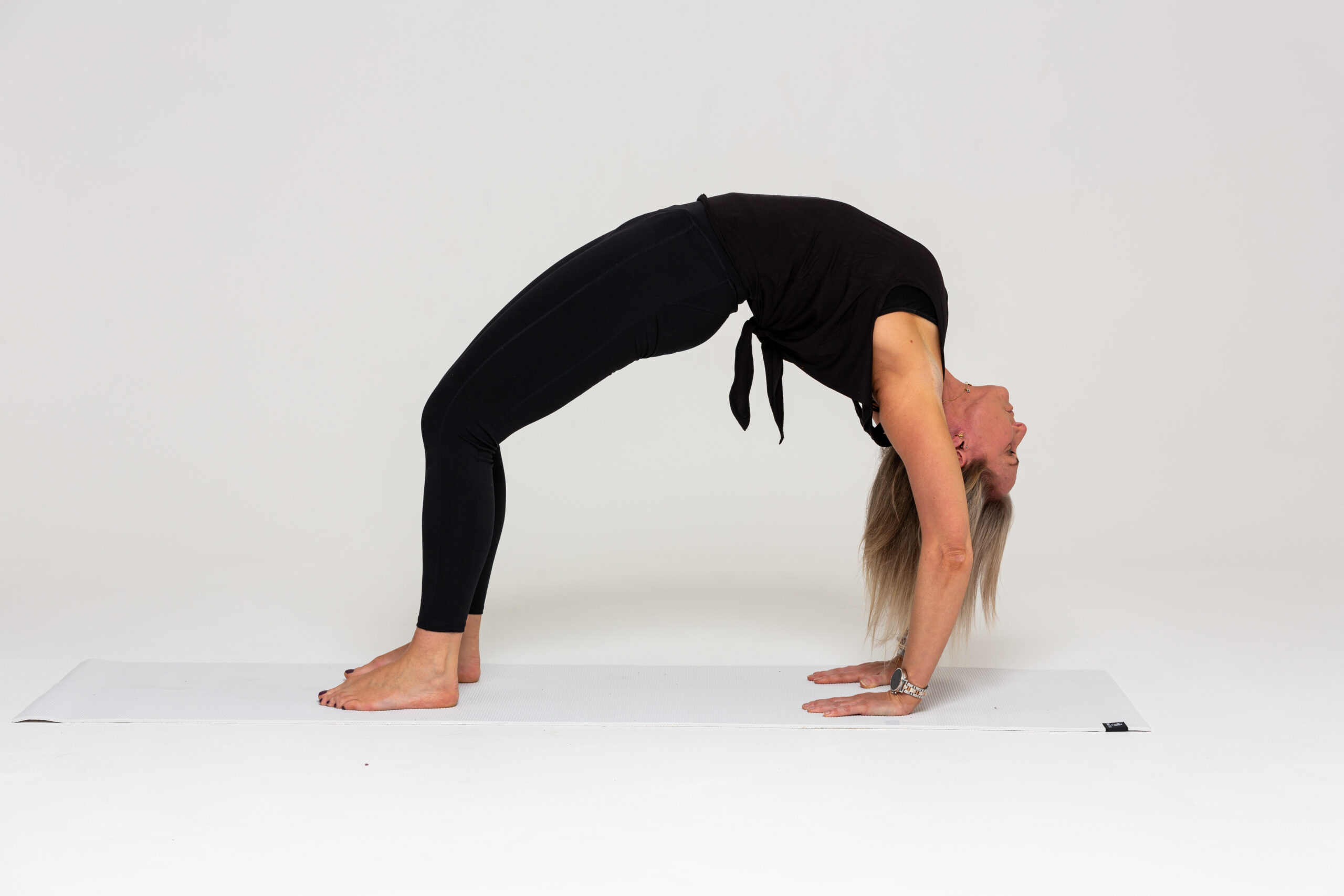
A personal story from our studio owner Clare.
Clare has just completed her 300 Advanced Ashtanga training with Kino Macgregor and Tim Feldmann and has so many new insights and perspectives to share starting with this Journey to backbends piece.
Why back bends?
Backbending postures are an excellent way to strengthen the spine and open the front of the chest. We tend to spend hours leaning over computers and rounding over mobile phones to text, causing our shoulders to round forward, which can create a plethora of problems in the spine and the rest of the body.
Along with cultivating healthy postural habits in our daily lives, working with backbends can help to bring balance back to the body.
My Journey
My journey to backbends has been a real journey. I have 3 fractured vertebrae in my spine which was the original reason I started yoga to ease pain and take some form of physical exercise. This happened as I had 2 very violent seizures and second one, actaully almost killed me.
I remember absolutely nothing about the whole episode As I progressed through my yoga journey and discovered Ashtanga, right from the very first time I started attempting Urdhva Danurasana I could not understand the overwhelming sense of emotion that I felt and very often became tearful not just attempting the pose but also at the thought of attempting it I felt completely dis-orientated in the pose, lacking strength in my arms plus legs and the correct flexibility in my shoulders. This was compounded as my breath would shorten and I almost go into panic mode.
Many of my previous teachers have passed off the feelings I was having saying that this would subside with time. So, it is not until I came on these 2 courses that I fully appreciated the layers of emotion and sadness that could be released through the asana practice. As you open up your body, old stuck emotions can be released.
Furthermore, as has also been pointed out to me – back bending builds strength in my back which is essential but only if done correctly and under the guidance of a good teacher.
In order for me to reap the benefits of backbends, on both a physical and emotional level the asana sequences need to address very specific key actions. Regardless of which backbending posture you are working up to you need to start to understand the pillars of backbending…
Spinal Movement
An awareness of the natural curvature of the spine, the distinct areas, and their differing ranges of movement. The cervical spine (neck), the thoracic spine (middle and upper back) and lumbar spine (lower back) and sacrum (the triangle-shaped bone above the tailbone).
In all backbends the notion is to equally distribute the bend throughout the entire spine, lifting the energy from the base of the spine all the way through each joint until it reaches the top of the head.
When backbending, it’s common for students to hyperextend (backbend too much) in the lumbar spine, and to toss the head back, jamming the back of the neck, while not moving the thoracic spine much at all. Therefore, to create a seamless, even backbend, focus on backbending in the thoracic spine can then be referred to throughout their practice.
This has been the most challenging for me as I have restricted the movement in my thoracic without realising it and probably built-up fascia tissue
Have each student place the narrowest side of a yoga block between the shoulder blades The closer the block is to the ground, the deeper the backbend). The block pressing into the thoracic spine encourages an evenly supported backbend throughout the spine, which can serve as a cue to be reiterated throughout the practice.
Shoulders
In a wheel pose, the arms are flexing at the shoulder joint. It is important to know what is happening in the shoulders to build and support your asana.
Hip Flexors
The hip flexors are commonly activated in everyday life when one sits for hours on end. So how do we stretch them out?
Backbending, of course! Backbends demand hip extension, which is only possible if there is length in the hip flexors, specifically the psoas. The psoas originates at the bottom of the thoracic spine and all five vertebrae of the lumbar spine and runs down across the front of the pelvis to attach at the notch on the inner thighbone called the lesser trochanter. When this muscle restricts hip extension, it tends to pull the lumbar spine and the pelvis forward, destabilizing the lumbar spine and eliminating the possibility for a balanced curve.
Consider incorporating poses that stretch and release tension in the hip flexors into your sequence. You might discover that they help to make backbends feel far more accessible!
Quadriceps
Legs provide a tremendous amount of support in backbending. Neutral legs—legs neither externally nor internally
rotated—offer the best foundation for backbending. External rotation of the legs is especially common in backbends and can compress the lower back.
To reduce this crunching sensation and move toward an even backbend, work the legs toward neutral by rolling the inner thighs in toward one another. You can first work with cultivating neutral legs in standing poses like (mountain pose) and (pyramid pose). Additionally, coming into bridge pose with a block between the inner thighs offers an excellent way to work the neutral leg action in a backbend.
The Emotional Journey of Backbending
I am not the first student to perhaps feel this is my stumbling block.
Backbending often brings up strong emotions either rational or irrational. But a very good saying I use often is
Stepping stones or stumbling blocks – what is the difference – perspective. Healthy technique and anatomical awareness are crucial to the long-term practice of backbends.
Be aware that when learning how to safely bend your back you may experience rational and irrational emotions. Sometimes the most flexible students have the most troubling emotions arising when they start practicing
backbends.
One of the deepest lessons in the yoga practice is about bringing the energy up the spine and cleansing the nervous system. Backbends thrust your full life force up through this central channel and burn through blockages along the way. When one of these blockages gets triggered, it really does not matter whether you are doing a deep backbend or a beginner backbend because the emotional state that gets triggered is really of paramount importance.
When things are difficult, scary, and emotional it is hard to remain clam, breathe and think clearly. This is where the
guidance of an experienced teacher is crucial. They can support your process, direct your body with sound instruction and finally give the process back over to you when you’re ready.
One of the most intense series of backbends occurs in the Ashtanga Yoga Second Series which I am yet to get to, and I must stop myself daily with the constant list of excuses why I will never be able to achieve this in my life time. Whilst at a David Swenson workshop he encouraged us to work into variations of drop back kneeling and
for some reason this took some of the fear out of the pose for me.
If I remember the healthy alignment principles of backbending and to take time with the movements equally distributing the bend throughout the entire spine. Draw the lower stomach in the spine in Dhanurasana and breathe into your belly.
Whatever your negative feelings are; disorientation, anxiety, sadness, emotional or physical discomfort when practicing backbends regularly the key is to learn how to stick with the practice and work through these feelings with a strong focus on the breath. The natural tendency is just to run away when the going gets tough, but the practice of Ashtanga Yoga teaches you how to navigate your way through whatever obstacles may arise in your
life experience.
It might not be the most enjoyable ride for a while but if you to stay on the course and use sound anatomical alignment, deep breathing, and a positive attitude you will get through.
